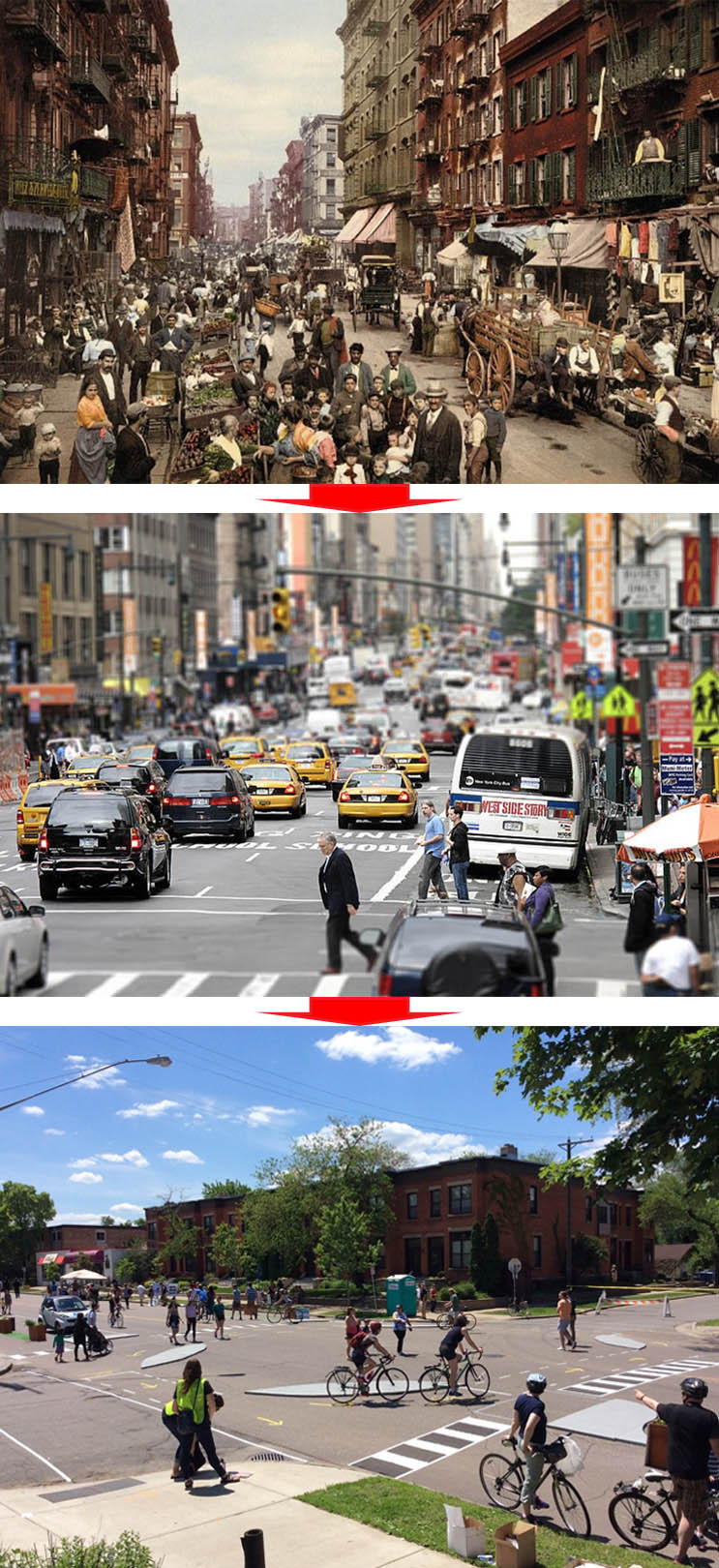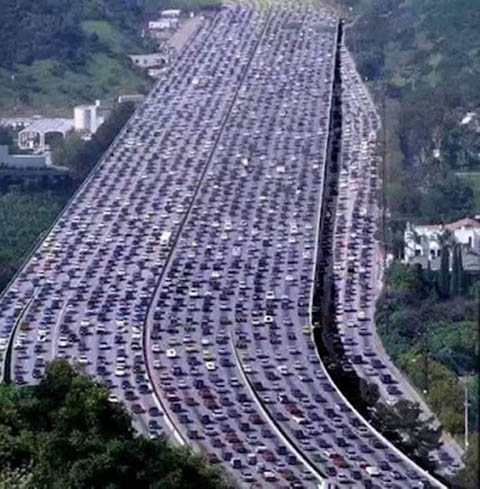
My time machine is still not quite working, but I now have read-only access to the internet of the future via the Wayforward Machine.
SUNDAY, DEC 27, 2357
The Future of Transportation:
How transportation needs were met
Eric Lee, A-SOCIATED PRESS
TOPICS: TRANSPORTATION, FROM THE WIRES, CYCLES, ROLLER CULTURE, HISTORY
Abstract: Imagined information from the future reframes our view of transportation post-car culture.
TUCSON (A-P) — Some details had been known, but further use of the Wayforward Machine (Info Ether, 2353) allows for a clearer picture. The basics will be repeated, but details added and the reasons behind them. By 2353, the new norms had been universally embraced so humans, rather than machines, could dominate their humanscapes.

The old auto roads were not as smooth as they once were but they were still present and maintained. Long distance e-trucks carried patch material and the e-driver placed it in any developing cracks or potholes while still very small without even having to slow down. All the old four-lane roads became multi-use paths. The high speed lane was for emergency vehicle use, high-speed velo-cycles, and long-haul e-buses that could go up to 50 km/h. There were few such vehicles in use at any one time so the high speed lane (called the Highway) was mostly used as a passing lane for the rollers, local e-buses, e-trucks, and rolling rooms.
All two-lane roads and urban/suburban streets became Cycle/Strollways. Speeds of e-vehicles on Cycleways were limited to 20 km/h (12 mph) though human powered vehicles could go 30 km/h (18 mph). This encouraged human rollers to roll on as long as they could before being forced to use e-cycles as their strength failed them at length. What had once been "shoulder" for the cars who broke down to pull over on became Strollways for the walking endowed. On Strollways, walkers could fast walk or jog up to 8 km/h (5 mph), as could human-power-only cyclists and skaters, but all e-assisted or powered vehicles were limited to 4 km/h (2.5 mph), typical walking speed, when of necessity they had to cross or otherwise use a Strollway. Walkers could see the e-truck coming and most kindly stepped out of its way so it didn't have to make a sudden stop. On Strollways walkers had the right of way and the idea of being hit by a car came to be considered something of a joke. The last pedestrian killed by a car was in 2121.
All e-vehicles had GPS and knew where they were and what the speed limit was. One or more wheels had hub-e-motor assist that could go into a regen mode to generate electricity. On Strollways with downhill stretches, the motors would generate power to keep the speed down to 4 km/h. If a cyclist pedaled, more power would be generated, but the vehicle would not go faster. On Cycleways regen would keep the speed below 20.9 km/h no matter how hard the cyclist pedaled to get a workout. Most e-cycles were used only by athletes to get the workouts they craved or by the handicapped who couldn't pedal 20 km/h. Unlike in the old days, it was the average fit, riding unassisted cycles, who blew passed the athletes when using Cycleways or Strollways. But on the Highways the Athletes could go 50 km/h (31 mph) by pedaling hard and using all the power-assist they had generated by regen. The handicapped (and with age everyone became handicapped) generated power only going downhill and so stayed on the Cycleways happily going at 20 km/h while the very fit rollers could pass them at 30 km/h.
Of course some very fit humans could pedal faster than 30 km/h on the Cycleways and most could go over 8 km/h on the Strollways. Some, using velomobiles, could even speed on the Highways (but so few humans could that speeding under human power on the Highway was overlooked). Those with so much excess human power as to speed on Cycle/Strollways were forced to ride e-cycles that would capture their excess power. Those exceeding the limits to speed ended up on e-vehicles going slower than the human power limit. This meant that the very fit were highly motivated to moderate their speed to fit in with other users of the Cycle/Strollways and save their need for speed for the Highways.
E-cycles had become common in the 21st century, but the formerly car-endowed who rode them thought that because some humans could pedal 40 to 130 km/h (25 - 81 mph) that, for the effort of twisting a throttle, they should too. At a minimum, 25 km/h or 32 km/h (15 mph or 20 mph) was demanded and considered a minimum average speed necessitating going at least 45 km/h (28 mph) at times to make up for having to sometimes stop at intersections. As the number of e-cyclists increased the multi-use cycle/pedestrian infrastructure became unsafe for mere average human powered cyclists and walkers, and so e-bikes had to be banned, forcing them to impede the traffic of the car-endowed who also came to demand that they be banned. It was only by building speed limits into e-vehicles that they could coexist with walkers and human powered rollers. As "speeding" was not an option, except under human-only-power, few were tempted to commit mayhem, and death or injury by vehicle became rare as was death by gun.
As a result, humans came to live long and prosper within limits. In the post-car world of 2062 all vehicles not powered by only human power where limited to 4 km/h on sidewalks that evolved into Strollways, and 20 km/h on Cycleways. This allowed transportation to be dominated, as it had up to the 20th century, by humans.  Overpowered machines were finally put in their place and e-power used only to enable the handicap to keep up or moderate the athletic allowing them to get their workout. All jaywalking laws were repealed and all streets, as Cycle/Strollways, once again became playgrounds for children and gathering places for social animals.
Overpowered machines were finally put in their place and e-power used only to enable the handicap to keep up or moderate the athletic allowing them to get their workout. All jaywalking laws were repealed and all streets, as Cycle/Strollways, once again became playgrounds for children and gathering places for social animals.
To create humanscapes, humans and human power must dominate. Otherwise you get a machinescape, a 21st century world unfit for humans and other living things to inhabit.
Massive vehicles, trucks and buses, had the potential to commit mayhem and did so until their potential was moderated by e-drivers who felt no need for speed nor to be inattentive. E-drivers were content to go 20 km/h or less and make distance when the sun was shining upon them just as sailors made distance when the wind blew. Photon sailors made greater distance over land by e-wheel than the ocean wind sailors did, but both were fast enough to serve a global civilization. At night or on dark and stormy days e-drivers were willing to go nowhere as e-sailors were when no wind blew.
Sailing barges moved materials about the globe by sail. Solar panels powered the wenches, rudder, hoisting and lowering of sails, and recharged the small battery bank used to power props for close quarter maneuvering while docking. The e-sailors replaced the need for humans to sail the barges that moved about the globe at the speed of a slow walker.
While some recreational gliding and soaring was done, air transport was used only for emergency medical reasons as the power requirement for high-speed flight was excessive. Outlying communities could transport the critically ill by wheeled ambulance to the city, but on rare occasions high-speed transport was the only hope. Patients were put into an e-glider with e-nurse monitored by Big City doctors. A large tank of compressed air and water on a track was used to accelerate the glider and launch it and it's booster tank upwards. The booster tank, also a water rocket, assisted the glider to the needed height. The booster tank then glided itself back to base and the e-glider's e-piolit soon landed next to the Big City hospital where it was refilled and launched to fly itself back.
Unmanned flying machines, however, were common. Satellites were launched into high atmosphere positions by hydrogen balloon. Solar or hydro electric generated the hydrogen and the solar satellites produced extra power for slow maneuvering above all clouds. The aerosatellites supported the global Info Ether's wi-fi and planetary monitoring system. If a satellite were to "go Hindenburg" (they didn't), it merely deployed its parafoil and glided back for relaunch. By 2357 enough fuel could be concentrated that, for the advancement of science, humans could once again launch "real" satellites into orbit, but the power required to support space exploration was so high that the far more efficient aerosatellites were used for lesser purposes. In 2357 machines were less powerful but far smarter than those in the 21st century.
The entire land transportation system, other than rail, was based on the bicycle wheel. The unpowered wheels were virtually identical to those of the 20th century. The e-powered wheels, used by e-cycles, e-buses, and e-trucks had hub motors that could provide up to 250 watts of power. E-cycles and e-trikes in hilly areas often had two. One was a direct drive/regen enabled motor and the other was a geared hub motor used only for hill climbing. The direct drive hub motors, like the unpowered wheels, had one moving part--the wheel that went around the axle. They typically lasted 80 to 110 years before requiring servicing. They were almost never thrown away but were rebuilt. The occasionally used geared hub motors typically needed their gears replaced every 20 to 30 years, a 20 minute job. If an e-wheel failed, it could be swapped for one that worked and repaired. Transportation in the 24th century was quite reliable.
E-buses and e-trucks had clusters of e-wheels on each corner. Clusters were of 4 to 8 wheels or 16 to 32 e-wheels per vehicle as needed depending on it's load. The 32 wheeled vehicles used 250W e-wheels and the 16 wheeled ones used 500W hub motors. The available power was limited by the solar array. E-vehicles had batteries, but they were small, less than 10 ah/person, as they were only used to assist with hill climbing or to get to a stopping point if clouds came in or the sun was getting too low to provide enough power. Trips were planned based on the weather forcast and the e-buses did not run at night nor on time. Stranded cyclists were rare and assistance was porvided for. Heavy vehicles in hilly areas needed the most batteries, but none used as much as 21st century electric cars had used. Having to wait for the sunshine was an option for all but emergency medical and police vehicles, but their need for speed was rare. All e-vehicles, except for e-cycles used in mostly flat areas, were all-wheel drive and could travel on unpaved roads. Tires were retreaded as they wore out.
E-buses, e-trucks, and rolling rooms were of a standard size: up to 14 m long (46') and 2.6 m wide (8.5'), which was also the size of the solar array that covered them, about 6,000 watts nominal power. Long-haul e-trucks were up to 23 m long (75'). E-trucks could also ride the rails. They drove onto the rail car and hooked in, their wheels able to drive the steel wheels. All were electrically connected too and on the mostly flat areas fed their excess power to the engine as well as powering their own wheels. The engine's battery bank helped get over the hills and as they did not have to share the rails, long distance speed was higher than using the High/Cycleways. So e-trucks only used the Cycleways for local delivery and were rarely seen nor impeded cycle traffic.
Local e-buses carried two back to back rows of bench seats for walkers to sit on, up to 16 per bus. Handicapped cyclists could also use them. Those who could still pedal a few blocks to the nearest bus line could ride up to an extended docking port arm and dock, then be pulled in next to the long narrow bench seats for the walkers. Their cycles had a docker attached so they could just ride up and lock in without the e-bus having to slow down. They remained on their cycle and undocked at their destination to ride door to door. For comfort, the elderly came to prefer recumbent trikes and many adults came to prefer them too, so mainly kids and the very fit, who could mash the pedals hard enough to take most of their butt weight off the padded post, continued to ride upright bicycles. Up to 16 bikes or trikes could dock with e-buses. E-cycles were also an option for the handicapped, but only those who had saved up over the years when they were fit could afford them.
In the 21st century, so many were so addicted to speed that riding an e-cycle at 20 km/h was unbearable. Before all e-cycles were smart enough to cap their speed at 20.9 km/h no matter how hard they were pedaled or how far the throttle was twisted, e-cycles were so out of control at the wrists of the speed addicted that they had to be banned. At one point 89% of pedestrian fatalities were caused by e-cyclists. In one case, a judge resorted to having habitual offenders fitted with an e-throttle and be incarcerated at a children's amusement park where they had to give children piggy-back rides. The throttle, surgically implanted on top of their heads and directly wired into their brain, made them move as fast as they possibly could at full throttle. Virtually all of the kids would hop on and twist the throttle until it wouldn't turn anymore. The e-human would fail about and run as if being chased by a pack of rabid dogs until they couldn't go no more. The kid would get off, complain about the limited power of his e-human, and demand a more athletic one next time. They just wanted a good ride and viewed their pathetically underpowered e-human with contempt, often kicking them when they collapsed into a mass of twitching muscle until their throttle was released. A few offenders eventually learned how to ride an e-bike, but the program was canceled following a PETA protest.
Bottom line is: most average humans can and therefore do ride a bicycle at 10 to 20 km/h (6 to 12 mph). Environments where machines can go faster if the human merely wants to will be dominated by the machines and the merely human powered will feel forced to use the machines, whether e-bikes or cars. To live in a human world, moderate the machines. Make them serve human needs as opposed to manufactured wants.
